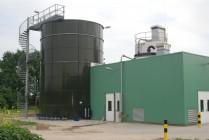PHOSPAQ™
The PHOSPAQ™ process is applied to recover phosphate from effluents as struvite. Phosphate is becoming scarce, thus making recovery more and more interesting. PHOSPAQ™ is a cost-effective technology compared to e.g. dosing of iron salts. Moreover, the produced struvite is an excellent slow release fertilizer for N, P and Mg.

The PHOSPAQ™ process removes biological degradable COD, phosphate (PO43-) and ammonium (NH4+) from waste water. With oxygen, the COD is biologically converted into new biomass and CO2. By adding magnesium oxide (MgO), phosphate and ammonium precipitate as struvite (MgNH4PO4.6H20 or MAP). The struvite granules are being removed from the water phase, and are ready for agricultural use (fertilizer). The struvite complies with EU standards for fertilizer.
PHOSPAQ™ is feasible from approximately:
- Load: > 100 kg P/d
- 50 mg/l PO4-P
- 200 mg/l NH4-N
The removal efficiency is about 70-95%.
Advantages of PHOSPAQ™
- Combined phosphate- and COD-removal in one reactor
- Aeration provides the oxygen for the biological conversion of COD
- Aeration provides optimal conditions for struvite formation
- Stripping of carbon dioxide raises the pH and stimulates struvite precipitation
- Good struvite quality
Working principle
The PHOSPAQ™ process takes place in an aerated reactor. Magnesium oxide is added to remove phosphate that is recovered by precipitation as struvite at a pH of 8.2 to 8.3. The PHOSPAQ™ reactor is equipped with separators that retain the struvite.
The struvite is harvested from the bottom of the reactor by means of a hydrocyclone, followed by a screw press and transferred into a container. The dry weight of the harvested struvite is around 50% and the crystals have an average size of around 0,7 mm.
PHOSPAQ™ cases
-
Production of fertilizer from potato processing wastewater...










